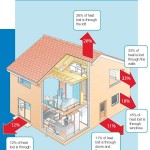Biggest Winter Home Energy Zappers
 Biggest Winter Home Energy Zappers
Biggest Winter Home Energy Zappers
Using the sun to add a bit of warmth to your home during the winter is just one small way to save energy during the season. Open blinds and drapes to allow the sun’s rays to warm your home. There are other tactics as well that will help winterize your home by targeting and correcting the biggest home energy zappers.
Drafts and Air Leaks
From leaky baseboards to drafty door and window frames, there are dozens of areas around the home that could be increasing your heating bills every year. Do a visual inspection around both the interior and exterior of your house, sealing any leaks with weather stripping, caulk or other insulating materials.
In addition to baseboards and door and window frames, interior areas most vulnerable include fireplace dampers, switch plates and electrical outlets, vents and fans, openings in walls created for cable lines or dryer vents, and meeting points between the walls and ceiling.
Any exterior area where two different building materials meet is a prime location for a leak. Check all exterior corners, water faucets and the junctions between the chimney and siding and roofing materials.
Poorly Insulated Areas
Another way to winterize your home and save energy is to ensure you have adequate insulation in your attic, basement and crawl spaces. Make sure your attic hatch is properly insulated, your attic’s insulating material has a vapor barrier beneath it, and the attic vents remain unblocked to promote ventilation to reduce indoor air pollution.
Shoddy Heating System Performance
Heating systems require regular maintenance for optimum performance, and that maintenance should include a professional maintenance check at least once each year.
If a heating system upgrade is in your cards, choose new appliances rated for high energy efficiency to save energy and money going forward.
Steady Thermostat Temps
Keeping your thermostat set at a steady temperature all day and night is not best way to save energy – or even get a good night’s sleep. Studies keep pointing to the optimum temperature for sleep at between 60 and 68 degrees Fahrenheit, a temperature that also helps you burn more calories while you’re snoozing.
Program your thermostat or manually reduce your indoor temperature before you head to bed, as well as during the day if you’re out of the house for extended periods or away on vacation.
As a leading home inspection company in Western New York, we know how brutal the area’s winters can be. But that doesn’t mean your heating bills have to be equally as brutal. Winterize your home and you can save energy as well as money with a significant dip in your home heating costs.


